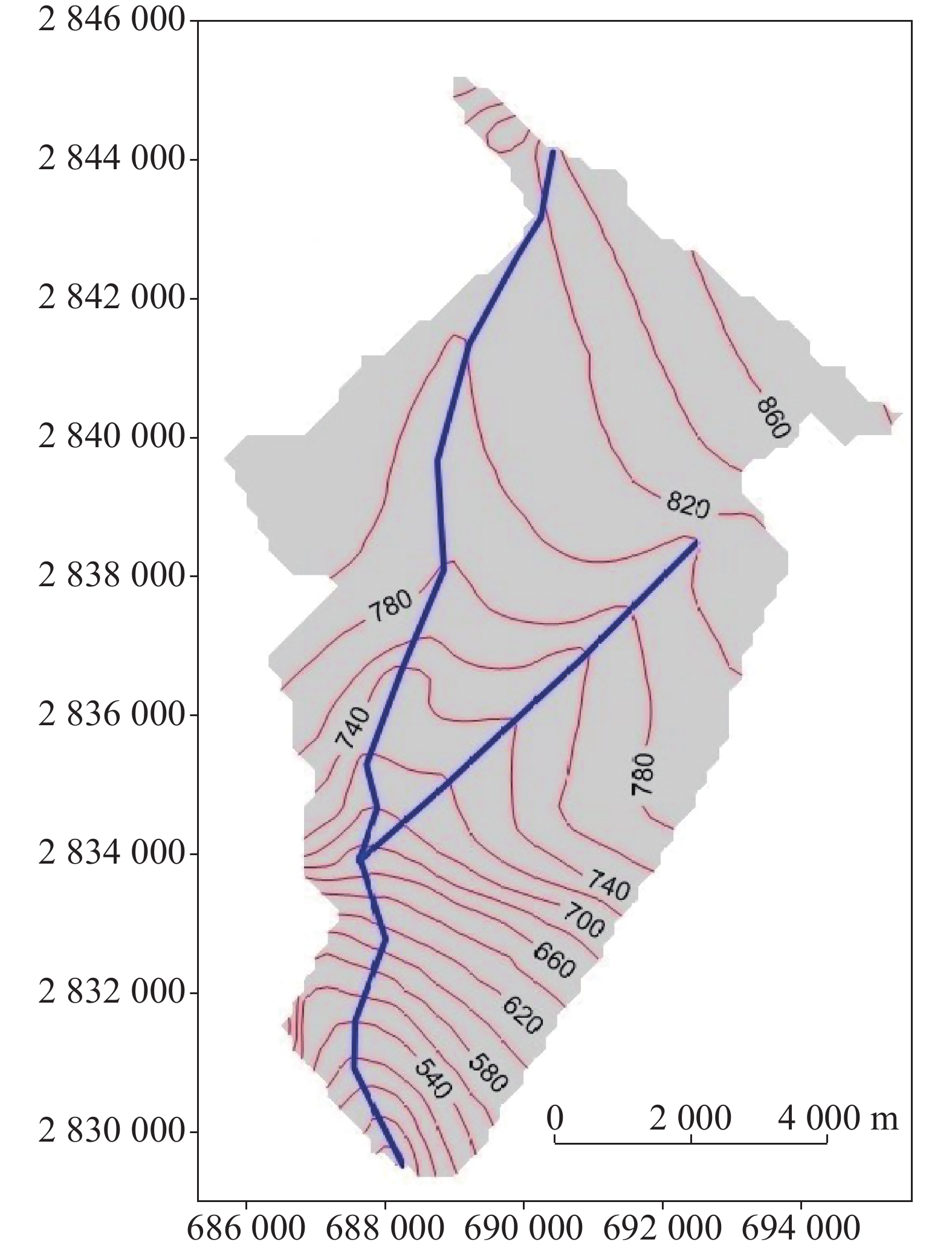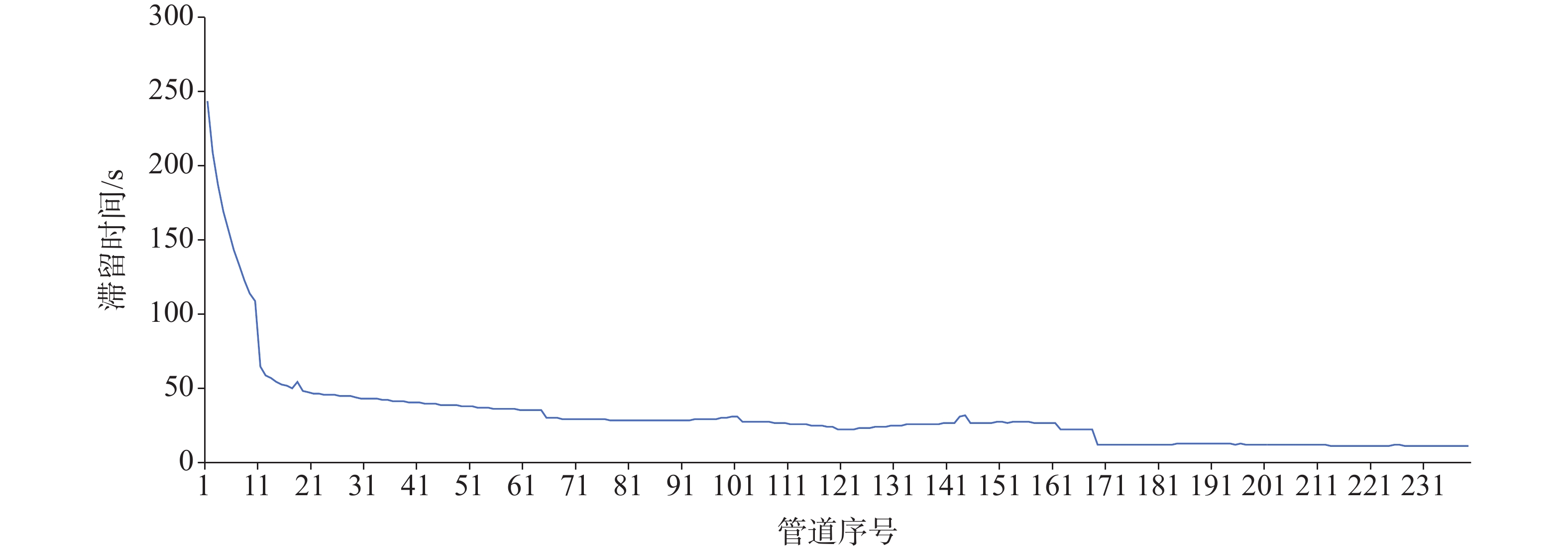Numerical simulation of karst groundwater in Dajing basin of Guizhou Province based on MODFLOW-CFP
-
摘要:
贵州大井流域岩溶分布广泛,岩溶水是当地人民生产和生活的主要来源。由于对岩溶水资源的不合理开发利用,水资源短缺现象经常发生。大井流域水文地质条件复杂,管道−多孔介质双重介质特征明显。文章采用MODFLOW-CFP耦合模型对大井流域展开数值模拟,进而掌握大井流域地下水运动规律、准确评价岩溶水资源,促进其合理开发利用。结果表明:大井流域管道与多孔介质交换量为6 719.1 m3·a−1,主要集中在上游和中游;总补给水量为10 977.3×104 m3·a−1,补给模数为133.495 m3·km−2·a−1,其中降雨汇入量和降雨入渗量占总补给量的81.35%,而总排泄量为10 813.47×104 m3·a−1,主要在地下河出口排泄。
-
关键词:
- 大井流域岩溶水 /
- MODFLOW-CFP耦合模型 /
- 岩溶管道模拟
Abstract:China is a country with the most widely distributed karst, and the karst is extensively developed in its southwesten part where 2,836 underground rivers are distributed with about 1,847.8×108 m3·a−1 of karst groundwater resources and a total discharge of 479.7×108 m3·a−1 in the dry season. These underground rivers become the main water source for people's life as well as the development of industry and agriculture in Southwest China. However, water shortage has often occurred in recent years, due to the unreasonable development and utilization of karst water resources. How to make scientific, reasonable and effective use of karst water resources has become a difficult problem in tackling water resource crisis. In this paper, we have studied the hydrological process and numerical simulation of groundwater in karst areas from the perspective of groundwater science, which is of great significance to the accurate evaluation, and rational development and utilzation of karst water resources.
In this study, we take Dajing basin, a typical karst peak-cluster depression area in southern Guizhou Province, as the study area. Water-bearing media in karst areas often include karst pipelines with high permeability and dissolved gaps with low permeability. The flow mechanism of groundwater in these two media is quite different. The groundwater in the gap mainly accords with Darcy’s law and the laminar flow mechanism, while the groundwater in the karst pipeline is mostly in the turbulent state due to the large flow rate. In the actual situation, the two media are independent of each other, but there is an interrelated process of hydraulic exchange on the boundary. Based on this, we adopt MODFLOW-CFP coupling model to carry out a numerical simulation of Dajing basin. MODFLOW-CFP is a dual-system coupling model based on dual structure theory. MODFLOW-CFP model contains three groundwater flow simulation methods. In this study, CFPM1, the most basic model, is adopted. In this pattern, the traditional groundwater flowing model is coupled with a specific pipeline model. The main purpose is to depict caves, cracks in interstitial space and basaltic aquifer pipes in karst aquifers, where groundwater can be fully or partially filled and flow patterns can be laminar or turbulent. Therefore, a complete simulation of the hydrological process of karst groundwater may help us to grasp the law of groundwater movement in Dajing basin, accurately evaluate karst water resources, and thus promote the rational development and utilization of the resources.
The process of using MODFLOW-CFP to establish a mathematical model of groundwater in Dajing basin includes the establishment of porous media model in MODFLOW and pipeline model in CFP. Subsequently, the two models are combined together to identify the model and analyze the water balance, based on the coupling model. Finally, the water resources are evaluated and the mechanism of groundwater migration is studied. In this study, it is found that Dajing basin is a groundwater system with complete recharge, runoff and drainage conditions, and the North-South and the Northeast-Southwest trending structures control the distribution of regional karst aquifers and the development of karst. According to the buried conditions of groundwater and the practical significance of water supply, the main source of recharge in this area is atmospheric rainfall, and the main discharge is the outflow from the southern Dajing basin. Meanwhile, the simulation results show that the exchange capacity between pipes and porous media is 6,719.1 m3·a−1, mainly in the upper and middle reaches of Dajing basin. The total recharge water in the study area is 10,977.3×104 m3·a−1, and the recharge module is 133.495 m3·km−2·a−1. The rainfall inflow and infiltration accounts for 81.35% of the total recharge, and the total discharge is 10,813.47×104 m3·a−1, mainly from the outlet of the underground river. Based on the research findings, the migration mechanism of groundwater in Dajing basin is clarified, and new development and utilization of water resources are put forward to address the shortage of local water resources.
-

-
表 1 校正后模型水文地质参数
Table 1. Corrected model hydrogeological parameters
地层/参数 渗透系数/m·d−1 给水度/m·d−1 降雨入渗补给系数 凉水井组 8 0.065 0.37 小米塘组 5 0.075 0.33 大冶组 3.15 0.055 0.22 吴家坪组 2.50 0.050 0.15 表 2 地下水均衡分析表
Table 2. Groundwater balance analysis
均衡项 水量/×104 m3·a−1 占比/% 补给项 降雨汇入(管道) 3 968.9 36.16 降雨入渗(多孔介质) 4 961.2 45.20 地下河入口流入 2 047.2 18.65 合计 10 977.3 100.00 排泄项 地下河流出 10 688.0 98.84 排水沟 114.47 1.06 蒸发 11 0.10 合计 10 813.47 100.00 均衡差 163.83 表 3 管道水均衡分析
Table 3. Pipe’s groundwater balance analysis
均衡项 水量/×104 m3·a−1 占比/% 补给项 降雨汇入(管道) 3 968.9 37.13 管道交换 6 719.1 62.87 合计 10 688.0 100.00 排泄项 地下河流出 10 688.0 100.00 合计 10 688.0 100.00 均衡差 0 表 4 多孔介质水均衡分析表
Table 4. Fracture water balance analysis
均衡项 水量/万m3 占比/% 补给项 降雨入渗(多孔介质) 4 961.2 70.79 地下河入口流入 2 047.2 29.21 合计 7 008.4 100.00 排泄项 管道交换 6 719.1 98.17 排水沟 114.47 1.67 蒸发 11 0.16 合计 6 844.57 100.00 均衡差 163.83 -
[1] 徐中平, 周训, 崔相飞, 拓明明, 王昕昀, 张颖. 岩溶区地下水数值模拟研究进展[J]. 中国岩溶, 2018, 37(4):475-483.
XU Zhongping, ZHOU Xun, CUI Xiangfei, TUO Mingming, WANG Xinyun, ZHANG Ying. Research advances of numerical simulation of groundwater in karst areas[J]. Carsologica Sinica, 2018, 37(4):475-483.
[2] 杨杨, 唐建生, 苏春田, 潘晓东, 赵良杰. 岩溶区多重介质水流模型研究进展[J]. 中国岩溶, 2014, 33(4):419-424. doi: 10.11932/karst20140405
YANG Yang, TANG Jiansheng, SU Chuntian, PAN Xiaodong, ZHAO Liangjie. Research advances on multi-medium flow model for karst aquifers[J]. Carsologica Sinica, 2014, 33(4):419-424. doi: 10.11932/karst20140405
[3] 范威, 陈植华, 牛俊强, 李伟, 王亮, 黄荷. 香溪河岩溶流域水系结构与洪峰特征关系[J]. 中国岩溶, 2021, 40(3):430-438.
FAN Wei, CHEN Zhihua, NIU Junqiang, LI Wei, WANG Liang, HUANG He. Relationship between the surface water system structure and the flood peak in the Xiangxi river karst basin[J]. Carsologica Sinica, 2021, 40(3):430-438.
[4] 黄亮, 赵卫权, 吕思思, 杨家芳, 苏维词. 喀斯特洞穴空间分布与河网密度关系研究:以贵州省为例[J]. 中国岩溶, 2020, 39(1):127-136.
HUANG Liang, ZHAO Weiquan, LYU Sisi, YANG Jiafang, SU Weici. Study on the relationship between spatial distribution of karst caves and drainage density: An example of Guizhou Province[J]. Carsologica Sinica, 2020, 39(1):127-136.
[5] 汤克轩, 赵楠. 可溶岩地层的地球物理特征及其地质解译[J]. 中国岩溶, 2019, 38(4):578-583.
TANG Kexuan, ZHAO Nan. Geophysical characteristics and geological interpretation of karst strata[J]. Carsologica Sinica, 2019, 38(4):578-583.
[6] 陈皓锐, 高占义, 王少丽, 胡亚琼. 基于Modflow的潜水位对气候变化和人类活动改变的响应[J]. 水利学报, 2012, 43(3):344-353, 362. doi: 10.13243/j.cnki.slxb.2012.03.002
CHEN Haorui, GAO Zhanyi, WANG Shaoli, HU Yaqiong. Modeling on impacts of climate change and human activities variability on the shallow groundwater level using Modflow[J]. Journal of Hydraulic Engineering, 2012, 43(3):344-353, 362. doi: 10.13243/j.cnki.slxb.2012.03.002
[7] Dong Y H, Fu Y M, Yeh T C J, Wang Y L, Zha Y Y, Wang L H, Hao Y H. Equivalence of discrete fracture network and porous media models by hydraulic tomography[J]. Water Resources Research, 2019, 55(4):3234-3247. doi: 10.1029/2018WR024290
[8] 韩行瑞. 岩溶水文地质学[M]. 北京: 科学出版社, 2015.
HAN Xingrui. Karst Hydrogeology[M]. Beijing: Science Press, 2015.
[9] 常勇. 多孔介质—管道二元结构的岩溶泉水文过程分析与模拟[D]. 南京: 南京大学, 2015.
CHANG Yong. Analysis and simulation of karst spring water process in porous media-pipeline dual structure[D]. Nanjing: Nanjing University, 2015.
[10] 吴月霞, 蒋勇军, 袁道先, 李林立, 杨平恒. 岩溶泉域降雨径流水文过程的模拟:以重庆金佛山水房泉为例[J]. 水文地质工程地质, 2007, 34(6):41-48. doi: 10.3969/j.issn.1000-3665.2007.06.011
WU Yuexia, JIANG Yongjun, YUAN Daoxian, LI Linli, YANG Pingheng. Simulation of hydrological response of karst spring to precipitation: Case study of Shuifang Spring, Jinfo Mt., Chongqing[J]. Hydrogeology & Engineering Geology, 2007, 34(6):41-48. doi: 10.3969/j.issn.1000-3665.2007.06.011
[11] 王益伟, 渠光华, 刘埔, 褚学伟, 段先前. 岩溶管道网络数值模拟方法研究进展[J]. 水科学与工程技术, 2019, 213(1):36-40. doi: 10.19733/j.cnki.1672-9900.2019.01.11
WANG Yiwei, QU Guanghua, LIU Pu, CHU Xuewei, DUAN Xianqian. Brief analysis of main engineering geological problems of a plain reservoir in North China[J]. Water Science and Engineering Technology, 2019, 213(1):36-40. doi: 10.19733/j.cnki.1672-9900.2019.01.11
[12] 赵良杰, 夏日元, 杨杨, 邵景力, 易连兴, 王喆. 基于MODFLOW的岩溶管道水流模拟方法探讨与应用[J]. 中国岩溶, 2017, 36(3):346-351. doi: 10.11932/karst20170308
ZHAO Liangjie, XIA Riyuan, YANG Yang, SHAO Jingli, YI Lianxing, WANG Zhe. Discussion and application of simulation methods for karst conduit flow based on MODFLOW[J]. Carsologica Sinica, 2017, 36(3):346-351. doi: 10.11932/karst20170308
[13] 薛亮, 于青春. 岩溶水系统演化中河间地块分水岭消失过程的数值模拟分析[J]. 水文地质工程地质, 2009, 36(2):7-12. doi: 10.3969/j.issn.1000-3665.2009.02.003
XUE Liang, YU Qingchun. Numerical simulation for the disappearing of a watershed divide in a karst groundwater system[J]. Hydrogeology & Engineering Geology, 2009, 36(2):7-12. doi: 10.3969/j.issn.1000-3665.2009.02.003
[14] 梅向阳, 王菁, 覃荣高. 云南曲靖市沾益区某向斜构造岩溶区地下水污染数值模拟研究[J]. 价值工程, 2019, 38(5): 144-148. doi: 10.14018/j.cnki.cn13-1085/n.2019.05.041
MEI Xiangyang, WANG Jing, QIN Ronggao. Numerical simulation of groundwater contamination in a Syncline Karst Zone in Zhanyi District of Qujing City, Yunnan Province. [J]. Value Engineering, 2019, 38(5): 144-148. doi: 10.14018/j.cnki.cn13-1085/n.2019.05.041
[15] 张春艳, 束龙仓, 程艳红, 张帅领. 落水洞水位对水文情景响应变化的试验研究[J]. 人民黄河, 2020, 42(6):46-52. doi: 10.3969/j.issn.1000-1379.2020.06.010
ZHANG Chunyan, SHU Longcang, CHENG Yanhong, ZHANG Shuailing. Experimental study on the responses of groundwater level changes in the sinkhole on different hydrology sciences[J]. Yellow River, 2020, 42(6):46-52. doi: 10.3969/j.issn.1000-1379.2020.06.010
[16] 杨郑秋, 杨杨, 邵景力. 基于MODFLOW-CFP的岩溶水模型降雨非线性入渗补给研究:以湖南省香花岭地区为例[J]. 中国岩溶, 2019, 38(5):691-695.
YANG Zhengqiu, YANG Yang, SHAO Jingli. Study on nonlinear rainfall infiltration recharge of karst water model based on Modflow-CFP: A case study of Xianghualing area, Hunan Province[J]. Carsologica Sinica, 2019, 38(5):691-695.
[17] 钱家忠, 汪家权, 葛晓光, 张寿全, 李如忠. 我国北方型裂隙岩溶水流及污染物运移数值模拟研究进展[J]. 水科学进展, 2003, 14(4):409-412.
QIAN Jiazhong, WANG Jiaquan, GE Xiaoguang, ZHANG Shouquan, LI Ruzhong. Advances in research for numerical simulation of contaminant transport and flow in North China type fracture-karst media[J]. Advances in Water Science, 2003, 14(4):409-412.
[18] 刘丽红, 李娴, 鲁程鹏. 岩溶含水系统水动力特征研究进展[J]. 水电能源科学, 2012, 30(7):21-24. doi: 10.3969/j.issn.1000-7709.2012.07.006
LIU Lihong, LI Xian, LU Chengpeng. Research progress on hydrodynamic characteristics of karst water-bearing system[J]. Water and Power Energy Science, 2012, 30(7):21-24. doi: 10.3969/j.issn.1000-7709.2012.07.006
[19] 李向全, 侯新伟, 张莉. 宁南深层岩溶地下水系统三维数值模拟[J]. 地球科学进展, 2004, 20(S1):143-147.
LI Xiangquan, HOU Xinwei, ZHANG Li. Three-dimensional numerical simulation of deep karst groundwater system in southern Ningxia[J]. Advances in Earth Science, 2004, 20(S1):143-147.
[20] 姜光辉. 融合生态学和提升岩溶水数值模拟技术的国际前沿研究[J]. 中国岩溶, 2016, 35(1):1-4. doi: 10.11932/karst201601y01
JIANG Guanghui. The research progress and developing tendency of karst water[J]. Carsologica Sinica, 2016, 35(1):1-4. doi: 10.11932/karst201601y01
[21] 张林. 贵州大小井地下河流域表层岩溶带结构及岩溶水开发[J]. 贵州地质, 2004, 20(1):54-57. doi: 10.3969/j.issn.1000-5943.2004.01.011
ZHANG Lin. A study of superficial structure of karst zone and exploitation of karst water at the valley of Daxiaojing underground river[J]. Guizhou Geology, 2004, 20(1):54-57. doi: 10.3969/j.issn.1000-5943.2004.01.011
-




 下载:
下载:







